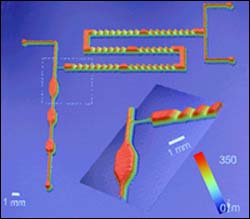New microfluidic device tackles tough synthesis tasks

NIST microfluidic device for synthesizing and analyzing polymers and other complex liquids.
A new type of microfluidic device that can help industry to optimize paints, coatings for microelectronics and specialty polymers has been developed by National Institute of Standards and Technology (NIST) researchers. The device is made of a chemically durable plastic that is resistant to many common organic solvents. It was fabricated with a rapid prototyping method also developed at the agency.
Described in the Aug. 18 issue of the Journal of the American Chemical Society,* such devices can be used to make specialty polymers in small amounts, or to rapidly change polymer ingredients so that the impact of expensive additives on material behavior can be systematically analyzed. This is becoming important as more specialty polymers use designer elements for applications in nanotechnology and biotechnology.
Devices typically measure about half the size of a credit card and are made with a technique called “frontal photopolymerization.” The NIST researchers adapted the technique to fabricating microfluidic devices. Ultraviolet light was shined through patterned “stencils” into a liquid layer of a chemical called thiolene. Areas exposed to the light harden into a solid polymer while unexposed areas remain liquid and can be flushed away, leaving relatively deep channels capable of handling thicker fluids than current lab-on-a-chip devices.
In a separate paper,** the NIST researchers provide detailed data about how varying doses of ultraviolet light affect the height of the polymer structures formed. Such data should be helpful for increasing the complexity of devices that can be fabricated with the technique.
Media Contact
All latest news from the category: Process Engineering
This special field revolves around processes for modifying material properties (milling, cooling), composition (filtration, distillation) and type (oxidation, hydration).
Valuable information is available on a broad range of technologies including material separation, laser processes, measuring techniques and robot engineering in addition to testing methods and coating and materials analysis processes.
Newest articles

Superradiant atoms could push the boundaries of how precisely time can be measured
Superradiant atoms can help us measure time more precisely than ever. In a new study, researchers from the University of Copenhagen present a new method for measuring the time interval,…

Ion thermoelectric conversion devices for near room temperature
The electrode sheet of the thermoelectric device consists of ionic hydrogel, which is sandwiched between the electrodes to form, and the Prussian blue on the electrode undergoes a redox reaction…

Zap Energy achieves 37-million-degree temperatures in a compact device
New publication reports record electron temperatures for a small-scale, sheared-flow-stabilized Z-pinch fusion device. In the nine decades since humans first produced fusion reactions, only a few fusion technologies have demonstrated…





















